In this article, we have implemented two different RFID based Attendance system Projects using 8051 Microcontroller and AVR (ATmega 8) Mirocontroller.
Attendance in colleges is generally paper based which may sometimes cause errors. Taking attendance manually consumes more time. So, the proposed attendance system uses RFID technology to take attendance.
In this system, each student is issued an RFID tag. Controlling unit is in the institute. Whenever the card is placed near the reader, it will take the attendance. This article explains the same.
But, before going to read this post, once get an idea about how to interface LCD with AVR Microcontroller as it is also included in this circuit.
Outline
ToggleConstruction and Output Video
RFID Based Attendance System Circuit Principle
RFID based attendance system consists of RFID Reader, RFID Tag, LCD display and microcontroller unit. RFID can be interfaced to microcontroller through USART. Data is transferred from RFID cards to reader and from there to microcontroller.
Radio frequency technology is used in many applications. RFID tags are of two types – 1) Passive Tags and 2) Active Tags. Passive tags contain 13 digit number tag inbuilt in it, where as active tag is read/write tag i.e. one can read from the tag and write to the tag. This project uses passive tag.
In real time, one can issue active tags to the students, with their roll numbers as their tags. RFID reader contains a copper winding in it. This winding acts as an antenna.
When the tag is placed near the reader, due to the induced mutual inductance energy, data is transferred to reader. Reader then transfers data to the microntroller. Microcontroller checks for the data continuously, if any data is received, microcontroller compares the data in data base.
If the tag is authenticated, microcontroller takes the attendance. Also you can check out the rfid based attendance system output video.
Circuit 1 RFID Based Attendance System Circuit Diagram using AVR
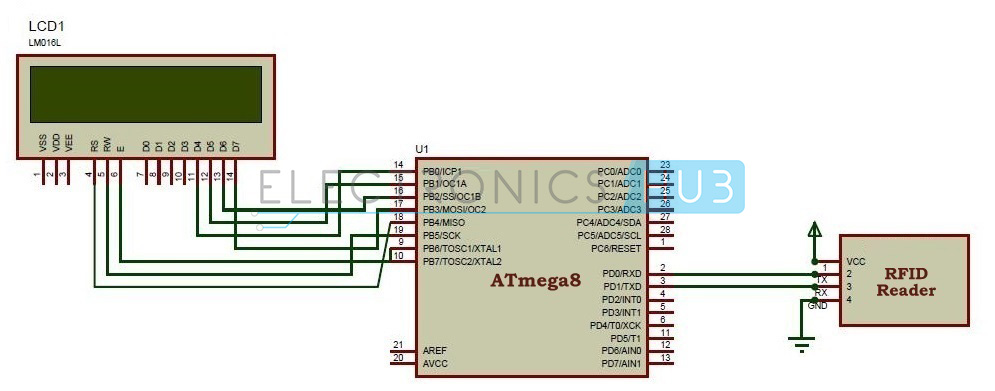
Circuit Components
- ATMEGA8 Microcontroller.
- RFID Reader
- RFID Tags.
- LCD display
Circuit Design of RFID Based Attendance System
RFID based attendance system has very simple circuit design. The RFID Reader has transmit and receive pins. These pins are connected to the transmit and receive pins of the micro controller i.e. PD0 and PD1 pins of microcontroller.VCC is connected to 5v and GND is connected to ground.
If pins are not available to the module, connect it using DB9 connector. PD0 pin is receiver and PD1 pin is transmitter.
Related Post: Biometric Attendance System using AVR Microcontroller.
RFID module communicates with the controller using USART, where USART is a communication protocol. USART is acronym for Universal Synchronous and Asynchronous Receive and Transmit.
Serial data can be transmitted from RFID module to microcontroller using UART. ATmega8 microcontroller has USART registers internally. One should declare these registers in order to transmit or receive data serially.
LCD display is connected to Port B of the microcontroller. Interfacing of LCD in 4 bit mode is in to microcontroller which is shown in the circuit diagram. D4 – D7 data pins are connected to the PB0 – PB3 pins of microcontroller.
RS pin is connected to PB4, RW pin is connected to PB5 and enable pin is connected to PB6 of microcontroller. To display data on LCD, initially set the LCD in 4bit mode. Then make Rw pin low, RS pin high, enable pin high. Send the data on data pins and make enable pin low.
DOWNLOAD PROJECT CODE
RFID based Attendance System Circuit Simulation Video
How to Operate RFID Based Attendance System Circuit?
- After making all the above connections, Switch on the circuit.
- On LCD it is displayed “PLEASE SWIPE THE CARD”.
- Place the RFID tag near the reader.
- Reader then reads the data in the tag and transmits to the controller.
- Microcontroller compares the tag with the database. If the tag is matched LCD displays “authenticated” and takes your attendance
- Now place another card which is not present in the database and check for authentication.
- Now LCD displays “Unauthorised” and it will never take the attendance.
- In this way, we can use implement this circuit.
Output Video (RFID Attendance System using AVR)
Circuit 2 RFID based Attendance System using 8051
The above circuit shows RFID based attendance system using AVR. Here is the same project but using 8051 microcontrollers. Let us see the circuit and working of this circuit.Circuit working principle is same as the above circuit.
Circuit Diagram
Components Required
- AT89C51 Microcontroller
- AT89C51 Programming Board
- 11.0592 MHz Quartz Crystal
- 2 x 33pF Ceramic Capacitors
- 2 x 10KΩ Resistor
- 10µF Electrolytic Capacitor
- 2 x Push Button
- 16 x 2 LCD Display
- 3 x 1KΩ Resistor
- 10KΩ POT
- EM-18 RFID Reader Module
- RFID Tags or Cards
- Connecting Wires
Circuit Design
The main components of the project are 8051 based microcontroller, 16×2 LCD, and RFID reader module.
First we’ll see the basic connections with respect to the microcontroller. Here, we’ll need to connect a crystal, a reset circuit and external access.
To use the on-chip oscillator, an 11.0592 MHz quartz crystal is connected to pins 18 (XTAL2) and 19 (XTAL1) of the microcontroller. Two 33pF ceramic capacitors are connected from the crystal to ground.
The reset on the 8051 microcontroller is active high i.e. upon applying a high pulse to RST pin, the microcontroller will reset. A 10KΩ resistor is connected from the RST (Pin 9) of the microcontroller to ground.
A 10µF electrolytic capacitor is connected between the positive supply and RST pin. A push button is connected across the capacitor.
The External Access pin (Pin 31) is connected to positive supply using a 10KΩ resistor. This completes the basic connections with respect to microcontroller.
Now we’ll connect the LCD to microcontroller. To adjust the contrast of the display, a pot is connected to contrast adjust pin i.e. Pin 3 of LCD.
First, connect the three control pins of the LCD i.e. RS, RW and E to P3.6, GND and P3.7. Then connect the 8 data pins of the LCD display to PORT1 pins of the microcontroller.
After connecting the display, now we are going to connect the RFID reader module. Connect the TX pin of RFID Reader to RXD pin i.e. P3.0 of the microcontroller. Similarly, connect the RX pin of RFID Reader to TXD pin i.e. P3.1 of the microcontroller.
Finally, a button is connected to P3.3 (IN) to view the attendance details.
Working
The aim of this project is to design an RFID Technology based Attendance System using 8051 microcontroller, in which the attendance of students or employees is automatically recorded with the swipe of a card. The working of the project is explained here.
When this circuit is powered ON, initially the microcontroller will display the message as Swipe the card on the LCD display. When the RFID reader detects the ID card, it will send the unique card no to the microcontroller via serial terminal.
With the help of suitable programming, we need to compare the received card no. with the numbers that are already stored in the microcontroller or any database.
Once, if any of these numbers are match with the received card no., then the corresponding name stored in that no. is displayed on the LCD display and also the attendance for the name stored in the corresponding number is marked.
By pressing the button, the attendance recording will be closed and the details are displayed on the LCD repeatedly until the microcontroller has been reset.
DOWNLOAD PROJECT CODE
Applications of RFID Based Attendance System
- RFID based attendance system can be used in educational institutions, industries, anywhere.
- RFID is emerging technology and is used in applications where authentication is needed.
Limitations of RFID Based Attendance System
- RFID attendance system is secured, but there is a chance of misusing the cards. One person can give another person’s attendance if he/she had RFID card.
- If the card was swiped for more than once, there is a chance of giving attendance for next days also if code is not written properly.

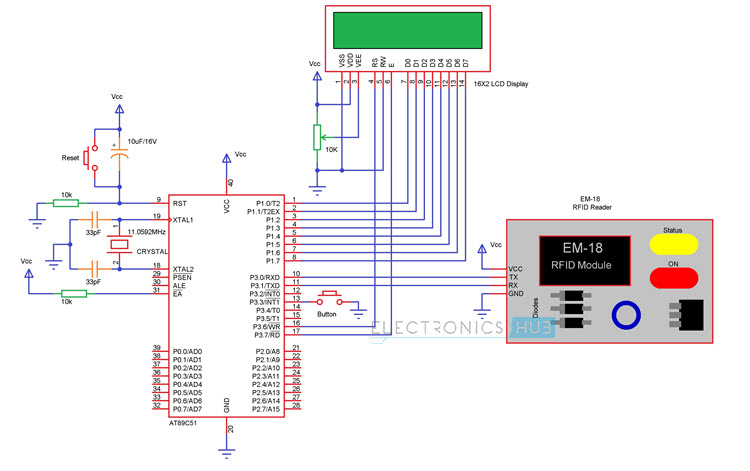
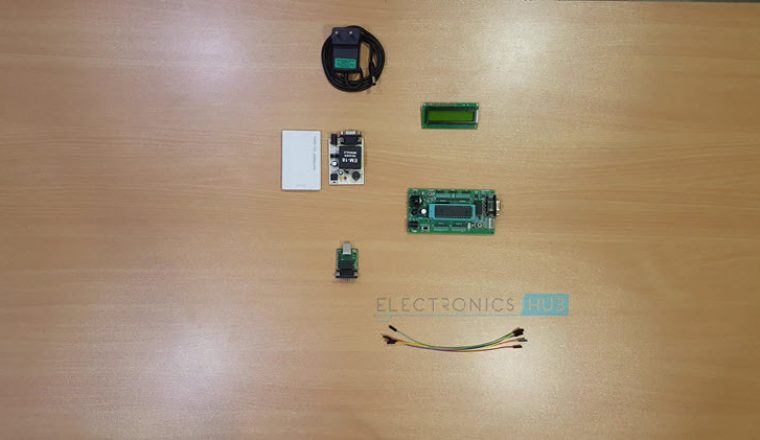
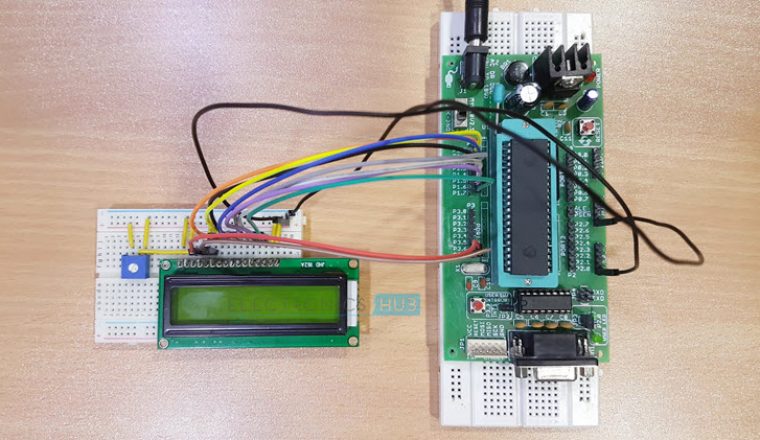
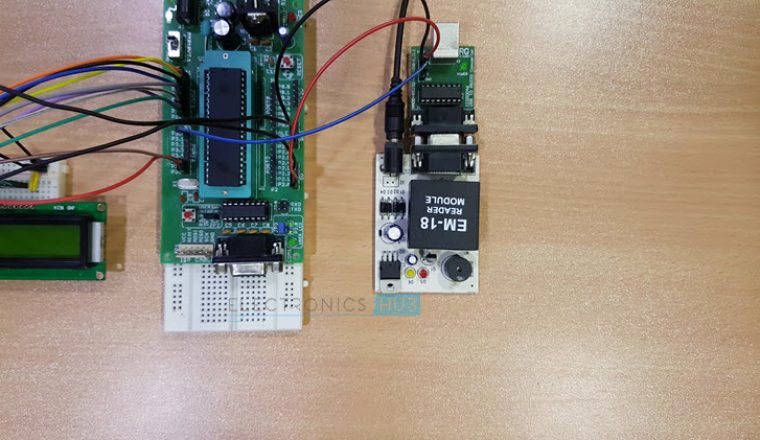
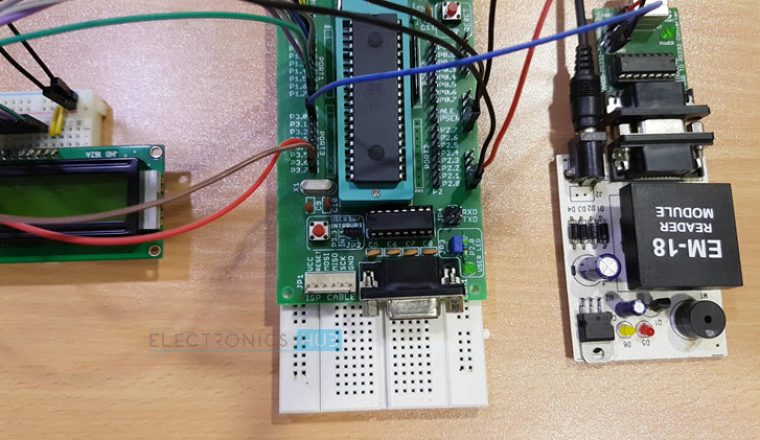
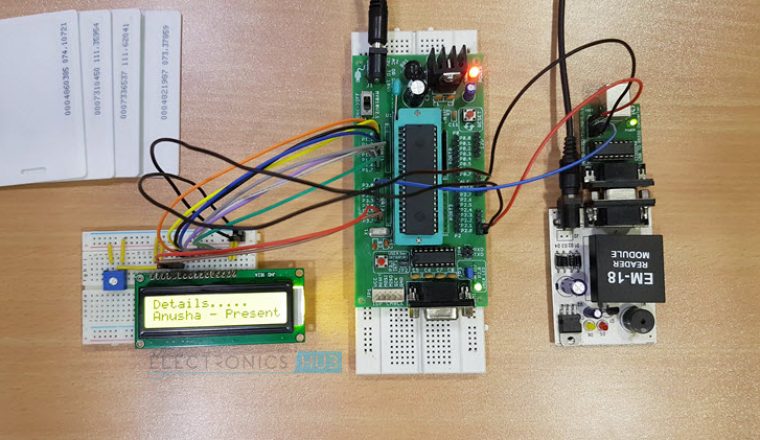

55 Responses
Thank you for sharing this project information along with circuit diagram. I truly appreciate your efforts.
its good. but i want to know how are u doing that images for circuit schematic i mean are u using any kind of software like that if so please let me know.
I think it is Proteus application
I’m a third year student and currently working on the same project and I need any kind of help about these project. We need to submit these project as early as possible. Thanks in advance.
I’m a final year student in a university I hope that my final project in school will reflect my interest in embedded systems and this is a step to archiving my embedded systems dream so………..please the code
thanks for sharing this project with us.
I am third year student and currently working on this project as our mini project. So, please i request you for the code and more details.
project code is Uploaded..Check in the article
please send me code
Project code is already uploaded along with the article.Please go through it
Which software shuld i use to debug the given program
Keil µVision for 8051. Atmel Studio for ATmega8.
Well,I am interested in making this project and project code would help me fulfill my quest.I will try this one and make some changes if necessary.
HOW RFID tag can be use ,i mean how information insert in tag ,by user or it is already contain information .
There are two types of RFID tags..Active tags,passive tags..For active tags you can load the information..but passive tags will have a 12 digit code in it…
Good work. Can I get one based on near field communication? I will really appreciate your assistance.
thanks.
hello mam, i’m a final student and m working on a project of biometric finger print attendence system and i need the programming code to be burn into the atmega8 microcontroller so please give me those code and their relevant details also
thank you
Hey I need the codes as I am doing this same project for my 6th sem mini project.I found your project very intresting and its different from other projects.Please send me thr codes and other additional details about the project.I will be very thankfull to you
sry i cant get project code so pls try to tell me where is the code
I need a code because I will make project RFID based attendance system.It is 8051 based on it . The software use in project is Keil version 4. We stimulated the project with the help of Keil Software.So please request for you give a code of this project.Its urgently.
hey what are the part no,. of reader module used
Send me code of microcontroller based attendence system.
1. I need this project code because in one or another way will help me to accomplish my project.
2. yes, i am trying to make the same project.
3. my project is to design and implementing the RFID BASED STUDENTS ATTENDANCE CONTROL SYSTEM WITH GSM at my college namely DAR ES SALAAM INSTITUTE OF TECHNOLOGY IN TANZANIA.
need this project code because in one or another way will help me to accomplish my project.
Code is Uploaded go through the article..
please send me the code of rfid based attendance system . because this is my final project of software engeneering . i want to make simple attandance of students and i need it very much. plz plz plz help me. Sir
Code is present in the post…You can download it..
Can I get a monthly report of every students attendance using this code?
please send me the code because i am doing the similar project with this for my final year project.Thank you.
Download the code from article..
How to know Passive RFID 12 bit code in order to access.
It is written on the tag
please send codes ……I need codes.
thank’s for sharing your knowledge…
I’m a final year student in a college
this tittle given for me from my advisor because the way of taking attendance in our country is paper based to improve this in educational system we want to change technological system so that I need this project .
yes l need exactly the same project with PDF simulation video or circuit diagram and running program
thank you!
Hi, i made the circuit on Proteus but the problem is that when i paste the same 12 digit code as you paste the LCD still displays ”card not matched Unknown person”, where do i get the the 12 digit codes that are on the database?
Open the code in avr studio…Change the 12 digit code to be changed compile it again and now paste your code in virtual terminal
Do we really need a avr development board? or simply the rfid tx/rx ports can be connected to the tx/rx port of controller?
Secondly maam, are these components enough?
lcd
controller
rfid reader/tags
can i simply implement the circuit which is being simulated in proteus?
sorry for my less knowledge!
thanks!
To implement this circuit practically…circuit shown in simulation is not sufficient….Controller should have clock ,reset circuits and for burning the code you need another circuit…If you can get a AVR development board..Everything will be present in it…This circuit simply shows the connections to which modules are connected..
HELLO MAM , ACTUALLY I AM UNABLE TO GET THAT VIRTUAL TERMINAL OR RFIID ON PROTEOUS 8
CAN U PLEASE SEND ME THE FULL NAME OF VIRTUAL TERMINAL THAT U R USING OVER HERE??
Virtual terminal is present by default in proteus..If virtual terminal window is not opened , when simulation is run Goto Debug>>Virtual terminal.
when i try to simulate this project it give me this error “PC=0x0252 [AVR USART] RX FRAME ERROE” so please if somebody knows what it means it would be helpfull
well, I’m an electrical engineering student at Karume Institute of Science and Technology.
l need exactly the same project with PDF simulation video or circuit diagram and running program
thank you!
I can’t find library for RFID reader in isis7 (proteus).
Which library should I add to isis to access the reader.
There is no RFID reader in proteus by default.We have used virtual terminal Instead of reader.You can create a component and get library files from other sources..
good day,
how i can import the project at atmel studio
thanks.
I want to simulate in Proteus, so which code files do i have add and how?
Thanking u 4 giving this projects this are very nice,i will do a mini project in this.
I am a second year student,i have been assigned with the mini project which will be able to help which would be utilized by the college only.soo please help me out with the code.
Is it a electronics project or telecommunications project ??
thank’s, very helpful
When i build the code given in rfid based attendance system using atmega8 then i will shows the errors(after adding all library required like lcd,EEPROM, usart etc)
So,what is the problem behind that
Thanks for the sharing Rfid project, because same my final year project, I am very useful this project video
Please Iam working on this project,by using barcode,help me on how to prepare code
Good Project. How to use Face Camera for this Project.